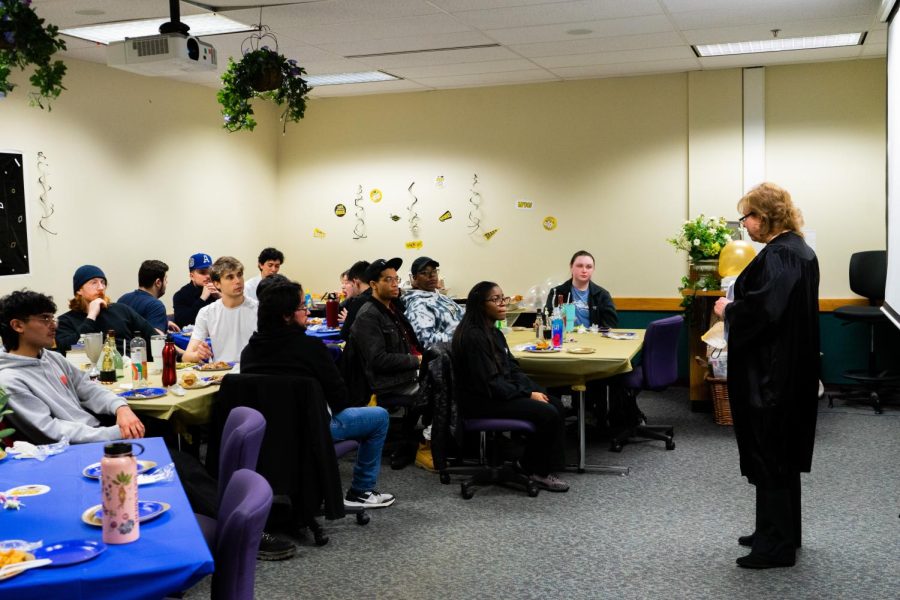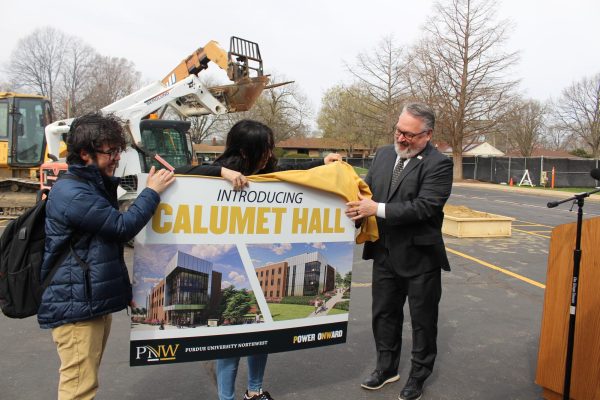Students learn about film over dinner and a movie
Students get ready to watch “The Graduate” during the Visual Aesthetics in TV and Film class on Wednesday night.. They eat dinner, hear a lecture, participate in two student-led activities and watch the required movie during this once-a-week class.
A retired professor has returned to the Hammond campus to watch classic films and television.
Associate Professor Emerita Mary Beth O’Connor is teaching a course she developed 20 years ago, “Visual Aesthetics in TV and Film”. It was designed to determine whether students could learn as much without traditional textbooks, assignments and tests.
Instead of all that, they meet weekly for dinner and a movie.
“Students have come back and told me they learned just as much, if not more, through this class because they were having a good time and they were relaxed,” said O’Connor.
Current students feel the same.
“The style of teaching is very helpful and provides a better chance of learning and retention of information,” said David Bolton, a junior Communication major. “It is a class that truly teaches movie fans, of any kind, what makes a film so beautiful.”
The class teaches more than just what makes a film.
“I believe it’s an experience of a lifetime,” said Nikki Brown, senior Communication major. “It broadens your mind. While you’ll gain knowledge about film, you’ll also leave with some valuable life lessons.”
The class is also teaching students about themselves.
“In college, we tend to focus on education but forget that we ourselves are still growing,” said Joey Kerber, a junior majoring in Visual Communication and Design. “This class has made me realize things about my own life that I would have never thought of before taking this class.”
At the start of the semester, students are split into groups and assigned to one of several films to complete what is called a Craft Services Assignment.
Each student group is responsible for hosting a film and dinner. Students hosting a given week must view their film ahead of the class and prepare a six-course meal, decorate the classroom and plan a simple in-class activity related to the movie, such as a trivia contest.
“What I enjoy most is the creativity the students can have when working on their craft service project,” said Amber Murray, a senior majoring in Communication with an Advertising concentration. “It requires you to look deeper into the themes of a movie and really analyze it. I love being able to come in every week and see what the theme will be.”
Though intended for Communication students, anyone can register.
The class meets in Porter 117 on Wednesdays. Students hosting that night’s film arrive up to two hours early to set up decorations and food. Once ready, they open the doors to their classmates who eat the meal while O’Connor lectures.
Each week’s film reflects the topic O’Connor has discussed. Topics covered include picture composition, lighting, acting, directing, continuity, cinematography, editing, storyline and costume.
For example, students watched the 1944 film “Laura” to demonstrate the use of lighting in film noir.
O’Connor said she added dinner to the class in response to students.
“They started getting cranky at about 8 p.m.,” she said. “When I asked them why, many students said that they worked all day and didn’t have time to eat. That’s what inspired me to integrate food into the class as part of the learning experience. Happy students, happy class.”
Students agree.
“I love that there is food every week,” said senior Caleb Perez, a Communication major. “I’m looking forward to when it’s my turn to host.”
Students are an influence on the course’s films. At the end of the semester they complete a survey rating each film on a scale of 1-5, based on likability, and explain what they learned from the film. O’Connor then uses a point system to determine whether a given film should be shown again. Films are also removed if a student expresses concern about the content.
It’s not clear if the course will continue to be offered.
“It’s possible the course will be offered in Spring 2024,” said Neil Nemeth, interim chair of Communication and Creative Arts.
“If the department wants me to teach it, I definitely will,” said O’Connor. “This is my favorite class to teach.”





